Papers by Nicholas Minter

Interpreting how far organisms within fossil assemblages may have been transported and if they al... more Interpreting how far organisms within fossil assemblages may have been transported and if they all originated from the same location is fundamental to understanding whether they represent true palaeocommunities. In a three-factorial experimental design, we used an annular flume to generate actualistic sandy sediment-density flows that were fast (2 ms −1) and fully turbulent in order to test the effects of flow duration, sediment concentration, and grain angularity on the states of bodily damage experienced by the freshly euthanized polychaete Alitta virens. Results identified statistically significant effects of flow duration and grain angularity. Increasing sediment concentration had a statistically significant effect with angular sediment but not with rounded sediment. Our experiments demonstrate that if soft-bodied organisms such as polychaetes were alive and then killed by a flow then they would have been capable of enduring prolonged transport in fast and turbulent flows with little damage. Dependent upon sediment concentration and grain angularity, specimens were capable of remaining intact over flow durations of between 5 and 180 min, equating to transport distances up to 21.6 km. This result has significant palaeoecological implications for fossil lagerstätten preserved in deposits of sediment-density flows because the organisms

Interpreting how far organisms within fossil assemblages may have been transported and if they al... more Interpreting how far organisms within fossil assemblages may have been transported and if they all originated from the same location is fundamental to understanding whether they represent true palaeocommunities. In a three-factorial experimental design, we used an annular flume to generate actualistic sandy sediment-density flows that were fast (2 ms-1) and fully turbulent in order to test the effects of flow duration, sediment concentration, and grain angularity on the states of bodily damage experienced by the freshly euthanized polychaete Alitta virens. Results identified statistically significant effects of flow duration and grain angularity. Increasing sediment concentration had a statistically significant effect with angular sediment but not with rounded sediment. Our experiments demonstrate that if soft-bodied organisms such as polychaetes were alive and then killed by a flow then they would have been capable of enduring prolonged transport in fast and turbulent flows with little damage. Dependent upon sediment concentration and grain angularity, specimens were capable of remaining intact over flow durations of between 5 and 180 minutes, equating to transport distances up to 21.6 km. This result has significant palaeoecological implications for fossil lagerstätten preserved in deposits of sediment-density flows because the organisms present may have been transported over substantial distances and therefore may not represent true palaeocommunities.

The colonization of land was one of the major events in Earth history, leading to the expansion o... more The colonization of land was one of the major events in Earth history, leading to the expansion of life and laying the foundations for the modern biosphere. We examined trace fossils, the record of the activities of past life, to understand how animals diversify both behaviourally and ecologically when colonizing new habitats. The faunal invasion of land was preceded by excursions of benthic animals into very shallow, marginal-marine environments during the latest Ediacaran Period and culminated in widespread colonization of non-marine niches by the end of the Carboniferous Period. Trace-fossil evidence for the colonization of new environments shows repeated early-burst patterns of maximal ichnodisparity (the degree of difference among basic trace-fossil architectural designs), ecospace occupation, and level of ecosystem engineering prior to maximal ichnodiversity. Similarities across different environments in the types of behavioural programmes employed (as represented by different trace fossils), modes of life present, and the ways in which animals impacted their environments, suggest constraints on behavioural and ecological diversification. The early-burst patterns have the hallmark of novelty events. The underlying drivers of these events likely were the extrinsic limitation of available ecospace and intrinsic controls of genomic and developmental plasticity that enabled trace-maker morphological and behavioural novelty.
Palaeogeography, Palaeoclimatology, Palaeoecology, 2015

We investigated excavation and nest site choice across sediment filled cavities in the ant Temnot... more We investigated excavation and nest site choice across sediment filled cavities in the ant Temnothorax albipennis. Colonies were presented with sediment filled cavities, covering a spectrum from ones that should be quick to excavate but will form a weak enclosing wall to those that should be slow to excavate but form a strong wall. Overall, colonies only showed a significant preference for cavities that were fastest to excavate over those that were slowest. Speed of decision-making and moving appear paramount over the suitability of the sediment for forming an enclosing wall. The mechanism behind the choice is the differential between the rates at which alternatives are excavated and accumulate ants. The rates for a particular type of cavity were unaffected by the type with which it was paired. This suggests that there is no significant competition between sites during the decision-making process. Certain colonies were able consistently to discriminate across more closely matched alternatives. These colonies required a greater number of ants to be present and took longer before beginning to move. A race is run between alternatives to become habitable but the process may be tuned across colonies such that it may run for longer and an incorrect or split decision is less likely.
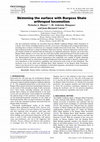
… of the Royal …, Jan 1, 2011
The first arthropod trackways are described from the Middle Cambrian Burgess Shale Formation of C... more The first arthropod trackways are described from the Middle Cambrian Burgess Shale Formation of Canada. Trace fossils, including trackways, provide a rich source of biological and ecological information, including direct evidence of behaviour, commonly not available from body fossils alone. The discovery of large arthropod trackways is unique for Burgess Shale-type deposits. Trackway dimensions and the requisite number of limbs are matched with the body plan of a tegopeltid arthropod. Tegopelte, one of the rarest Burgess Shale animals, is over twice the size of all other benthic arthropods known from this locality and only its sister taxon, Saperion, from the Lower Cambrian Chengjiang biota of China approaches a similar size. Biomechanical trackway analysis demonstrates that tegopeltids were capable of rapidly skimming across the seafloor and, in conjunction with the identification of gut diverticulae in Tegopelte, supports previous hypotheses on the locomotory capabilities and carnivorous mode of life of such arthropods. The trackways occur in the oldest part (Kicking Horse Shale Member) of the Burgess Shale Formation, which is also known for its scarce assemblage of soft-bodied organisms, and indicate at least intermittent oxygenated bottom waters and low sedimentation rates.
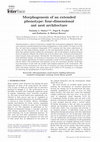
Journal of The …, Jan 1, 2012
Animals produce a variety of structures to modify their environments adaptively. Such structures ... more Animals produce a variety of structures to modify their environments adaptively. Such structures represent extended phenotypes whose developmental expression is rarely studied. To begin to rectify this, we used micro-CT scanning and time series experiments to obtain the first high-resolution dataset on the four-dimensional growth of ant nests. We show that extrinsic features within the environment, such as the presence of planes between layers of sediment, influence the architecture of Lasius flavus nests, with ants excavating horizontal tunnels along such planes. Intrinsically, the dimensions of the tunnels are associated with individual colonies, the dynamics of excavation can be explained by negative feedback, and the angular distribution of tunnels is probably a result of local competition among tunnels for miners. The architecture and dynamics of ant nest excavation therefore results from the local interactions of ants with one another and templates inherent in the environment. The influence of the environment on the form of structures has been documented across both biotic and abiotic domains. Our study opens up the utility of CT scanning as a technique for observing the morphogenesis of such structures.
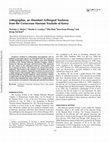
Ichnos, Jan 1, 2012
Trackways ascribed to Lithographus hieroglypichus and attributed to pterygote insects are describ... more Trackways ascribed to Lithographus hieroglypichus and attributed to pterygote insects are described from the Cretaceous Uhangri Formation of Korea. The locality is part of the Haenam Tracksite at the Uhangri Dinosaur Museum Complex, which is famous for dinosaur, pterosaur and bird tracks. This represents the first report of the arthropod trackway Lithographus from the Cretaceous of Korea. The trackways are preserved in cherty mudstones that formed in the margins of an alkaline lake in the vicinity of active volcanoes. Numerous trackways are preserved at a single horizon. This probably reflects a brief period of exposure of balanced-fill lake margin sediments, which provided a window of opportunity for the production and preservation of trackways of insects that inhabited the region, rather than a sudden influx of insects into the area related to volcanism and a productivity bloom.
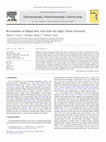
Palaeogeography Palaeoclimatology Palaeoecology, Jan 1, 2010
Published records of supposed Triassic bees nests are based on trace fossils in silicified wood a... more Published records of supposed Triassic bees nests are based on trace fossils in silicified wood and in sandstone in Upper Triassic strata of the Chinle Group in Petrified Forest National Park, Arizona. A critical, firsthand restudy of these trace fossils indicates that they lack diagnostic features of bees nests, such as cells with smooth linings and spiral closure caps. Indeed, many of the observations claimed to identify these traces as bees nests cannot be replicated. Instead, the putative Triassic bees nests can be classified as: 1. Clavate borings in petrified wood, somewhat similar to Teredolites; these borings preferentially penetrate heart-rot fungus (Polyporites) and are mostly likely larval chambers of wood-boring beetles. 2. Cylindical, vertical burrows in sandstone assignable to Skolithos; these are almost certainly arthropod produced. Recognition that the Chinle Group trace fossils are not bees nests eliminates them as evidence that decouples bee origins from the Cretaceous origin of angiosperms. The Triassic trace fossils in silicified wood are also a new and unique record of likely beetle borings in Triassic wood.
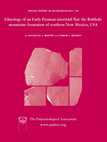
The Early Permian Robledo Mountains Formation of the Robledo Mountains in Doña Ana County, southe... more The Early Permian Robledo Mountains Formation of the Robledo Mountains in Doña Ana County, southern New Mexico contains a diverse and abundant nonmarine trace fossil assemblage. Invertebrate and vertebrate trace fossils both occur in abundance and formed in an upper intertidal flat setting, a long way inshore and essentially under nonmarine conditions. Eighteen invertebrate ichnogenera, including 16 established ichnospecies, one reassigned ichnospecies and two new ichnospecies are described and illustrated, together with nine trace fossils described in open nomenclature. Previously described vertebrate ichnogenera and ichnospecies are reviewed and illustrated, together with the description of one new ichnospecies, totalling ten ichnogenera and 13 ichnospecies. The ichnotaxonomy of Lithographus hieroglyphicus and Stiaria intermedia is also revised in light of the material from the Robledo Mountains Formation of the Robledo Mountains and comparative Early Permian material from the Early Permian Standenbühl Formation of the Saar-Nahe Basin near Frankfurt in Germany, the Hornburg, Oberhof, Rotterode and Eisenach Formations from the Thüringer Forest in Germany, the Coconino Sandstone Formation of Arizona, and the Shalem Colony Formation of the Robledo Mountains.
The invertebrate trace fossils from the Robledo Mountains Formation of the Robledo Mountains are dominated by arthropod trackways (Dendroidichnites irregulare, Diplichnites isp., Diplopodichnus biformis, Kouphichnium? isp., Lithographus hieroglyphicus, Octopodichnus cf. didactylus, Palmichnium macdonaldi, P. palmatum, P. pottsae and Stiaria intermedia), including several enigmatic arthropod trackways, as well as intergrading arthropod trackways (Diplichnites isp. × Diplopodichnus biformis, Diplopodichnus biformis × Dendroidichnites irregulare and cf. Lithographus × Diplopodichnus biformis), arthropod resting traces (cf. Lockeia, Rotterodichnium major, Selenichnites belosis nov. isp. Tonganoxichnus apacheensis nov. comb., and T. buildexensis), arthropod locomotory jumping traces (T. robledoensis), combined arthropod trackways and locomotory jumping traces (Stiaria intermedia × T. robledoensis), and arthropod grazing/raking traces (Stiallia pilosa and Striatichnium biflabellis nov. isp.). Invertebrate feeding traces (Treptichnus bifurcus) and grazing trails (Cochlichnus anguineus and looping trails) are present but rare. Trace fossils similar to the typically deep marine graphoglyptids are also present (cf. Spirorhaphe azteca), as well as horizontal helical-shaped burrows (Augerinoichnus helicoidalis) that may also have affinities with graphoglyptids. Further trace fossils described under open nomenclature include horizontal burrows and various enigmatic invertebrate trace fossils. The vertebrate trace fossils are dominated by tetrapod trackways (Batrachichnus salamandroides, Batrachichnus aff. salamandroides, Dimetropus nicolasi, D. leisneranius, Dromopus lacertoides, cf. Erpetopus, Limopus vagus, Gilmoreichnus hermitanus and Hyloidichnus bifurcatus), whilst tetrapod swimming trackways (Lunichnium rotterodium, Serpentichnus robledoensis and S. sigmoidalis nov. isp.) and fish swimming trails (Undichna bina, U. britannica and Undichna? unisulca) are also present.
The trace fossil assemblage can be considered as an example of the Scoyenia ichnofacies, although the presence of rare elements of the Mermia ichnofacies indicates that there are pre- and syn-desiccation suites of trace fossils. Cluster analysis of trace fossil distributions across nonmarine depositional settings from the Early Permian of the southwest USA reveals patterns consistent with previous models, based on qualitative observations, of the distribution of vertebrate trace fossils and their palaeoenvironmental implications. Comparisons of analyses conducted using the vertebrate, invertebrate and all trace fossils from the assemblages reveals that, for assemblages covering a limited temporal and palaeogeographic scope, vertebrate trace fossils allow greater potential for identifying trace fossil associations that enable discrimination amongst different depositional settings than invertebrate trace fossils alone, whereas a holistic approach, utilising all available trace fossil data, allows the greatest number of trace fossil associations, which correspond to different depositional settings, to be identified.
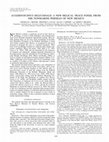
Journal of Paleontology, Jan 1, 2008
New Mexico contains a significant record of trace fossil assemblages, in terms of both abundance ... more New Mexico contains a significant record of trace fossil assemblages, in terms of both abundance and ichnodiversity, from Lower Permian nonmarine depositional settings. Most notable amongst these are the trace fossil assemblages in the Robledo Mountains Formation of the Robledo Mountains in Doña Ana County, southern New Mexico, as recognized by the recent proposal to designate this area as a National Monument. These trace fossil assemblages formed on a tidal flat under largely nonmarine conditions and are dominated by the trackways of tetrapods and arthropods, yielding important information on the paleoecology, diversity and behavior of late Paleozoic arthropods, as well as evidence of specialized foraging strategies. Additional Lower Permian trace fossil assemblages occur at a number of localities in New Mexico and represent a variety of nonmarine depositional settings.
The material described herein represents a new ichnogenus of helical burrow, named Augerinoichnus helicoidalis, and is recurrent across Lower Permian localities in New Mexico. Augerinoichnus occurs in tidal flat settings from the Robledo Mountains Formation of the Robledo Mountains, fluvio-deltaic coastal plain settings from the Robledo Mountains Formation of the Doña Ana Mountains in southern New Mexico, and floodplain sandflat settings from the Abo Formation of Cañoncito de la Uva in the Joyita Hills of central New Mexico, the McLeod Hills of central New Mexico and the Fra Cristobal Mountains of central New Mexico. The report of this new ichnogenus provides important paleoecological information on foraging strategies in nonmarine paleoenvironments, as well as further evidence for the occurrence of trace fossils in nonmarine settings similar to those considered indicative of deep marine depositional settings.
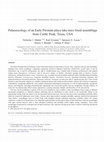
Palaeogeography Palaeoclimatology Palaeoecology, Jan 1, 2007
The Early Permian Choza Formation of the Clear Fork Group at Castle Peak in Texas, USA, contains ... more The Early Permian Choza Formation of the Clear Fork Group at Castle Peak in Texas, USA, contains a diverse and remarkably abundant trace fossil assemblage comprising exquisitely preserved arthropod trackways (Diplichnites gouldi types A and B, Diplichnites isp. A and B, Lithographus isp. and cf. Kouphichnium isp.), striated trails (Cruziana problematica) and isolated resting traces (Rusophycus carbonarius and R. furcosus), surface or shallow subsurface grazing trails or burrows (Gordia indianensis, Helminthoidichnites tenuis, Treptichnus isp., a nodular trail and unilobate epichnial trails), backfilled deposit-feeding burrows (Planolites beverleyensis), meniscate backfilled burrows (Taenidium barretti), horizontal branching networks, and tetrapod trackways (Dromopus palmatus, Erpetopus willistoni, Varanopus curvidactylus and cf. Amphisauropus isp.). Trace fossils formed in, and around the margins of, a shallow, ephemeral (playa) lake within an alluvial plain, and provide evidence of temporary communities, comprising arthropods, most notably notostracan branchiopod crustaceans, as well as euthycarcinoids, myriapods, insects, and tetrapods, including protorothyridid, captorhinid and araeoscelid reptiles and rare amphibians. Periodic influxes of water into the alluvial plain filled various depressions, creating temporary habitats and flourishes of life and activity.
The trace fossil assemblage is typical of the Scoyenia ichnofacies, and is similar to other assemblages from a range of different transitional subaqueous to subaerial settings, indicating that the distribution of trace fossils is not inextricably linked to the depositional setting itself, but rather to the environmental factors that arise. Such diverse trace fossil assemblages probably reflect relatively long-lived ephemeral water bodies, whereas more impoverished examples probably represent shorter-lived ephemeral water bodies. Assemblages such as Castle Peak, with abundant delicate arthropod trackways, probably reflect low energy conditions, conducive to the presence of an abundant vagile epifauna and the preservation of their trackways, whereas assemblages with open vertical burrows tend to lack arthropod trackways and probably reflect higher energy conditions. Trace fossil assemblages dominated by arthropod and tetrapod trackways may represent fleeting preservation windows following sheetfloods on floodplains.
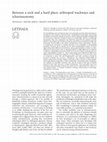
Lethaia, Jan 1, 2007
Several challenges exist in ichnotaxonomy: overcoming the perceived distinction between invertebr... more Several challenges exist in ichnotaxonomy: overcoming the perceived distinction between invertebrate and vertebrate ichnotaxonomy, standardizing terminology, rationalizing the plethora of ichnotaxa already in existence, and developing principles for diagnosing new ichnotaxa. Ichnotaxa should be based on morphology, and this morphology incorporates three key components; the behaviour expressed, the producer, and the substrate. Invertebrate and vertebrate ichnotaxa can both be accommodated within this framework, but they differ in the relative contributions of these components. The key to justifying the synonymy of existing ichnotaxa is the recognition of intergrading specimens. However, this is only the case for minor morphological variants (i.e. those representing minor differences in behaviour, such as gait parameters or stance; or minor differences in preservation, such as undertrack fallout or slight differences in substrate conditions). Intergrading specimens should not be used to justify synonymy between major morphological variants (i.e. those representing major behavioural differences, defined herein as ethological categories; or major differences in preservation, such as formation in soup, soft and firmgrounds), and such specimens should be denoted as hybrids (e.g. Cruziana × Rusophycus). New ichnotaxa should ideally be based on observations of large samples of material, so that recurrence is demonstrable, and morphological continuums, or subset relationships, representing minor morphological variation, are identified. Ichnotaxa may only be erected on the basis of limited material if they truly represent a unique morphology. These principles have been developed with arthropod trackways in mind, but it is hoped that they will be of more general utility.
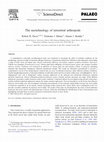
Palaeogeography Palaeoclimatology Palaeoecology, Jan 1, 2007
A comprehensive systematic neoichnological study was conducted to investigate the affect of subst... more A comprehensive systematic neoichnological study was conducted to investigate the affect of substrate conditions on the morphology and survivorship of terrestrial arthropod trackways. Experiments utilized five different extant arthropods, representing a range of body forms and higher taxa: discoid cockroaches (Blaberus discoidalis), emperor scorpions (Pandinus imperator), Chilean rose tarantulas (Grammostola rosea), African giant black millipedes (Archispirostreptus gigas), and common woodlice (Oniscus asellus). Trackways were produced on substrates of various grain size and moisture content, in protocols simulating subaerial and transitional subaqueous–subaerial depositional settings. The results are illustrated systematically to provide a comprehensive record of the morphological variation that can occur in arthropod trackways under different substrate conditions. General morphological trends, of increased definition of individual tracks and loss of tracks within series, are highlighted as “dry to dampground” and “soft to firmground” surface moisture taphoseries in the subaerial and transitional subaqueous–subaerial protocols respectively. Heavier arthropods produced trackways across a broader moisture and grain size range, whilst different arthropods can produce similar trackways under certain conditions. Undertrack fallout was investigated using discoid cockroaches, and the resultant undertrack taphoseries mimics the surface moisture taphoseries. Previous hypotheses on the factors that influence trackway survivorship were also investigated. Increasing concentrations of clay minerals exponentially increases the survivorship of trackways subjected to an air current, whereas increasing surface moisture has a linear affect, and a combination of the two provides excellent conditions for trackway survivorship. The results of this study are fundamental to the study of fossil arthropod trackways and can be used to aid ichnotaxonomic revisions, whilst also facilitating the identification of trace fossil producers and highlighting potential biases in palaeoecological reconstructions based on trace fossils.
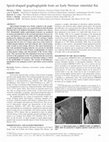
Geology, Jan 1, 2006
Spiral-shaped foraging trace fossils, assigned to the graphoglyptid cf. Spirorhaphe azteca, are r... more Spiral-shaped foraging trace fossils, assigned to the graphoglyptid cf. Spirorhaphe azteca, are reported from an Early Permian intertidal flat in the Robledo Mountains of southern New Mexico, USA. Remarkably similar spiral-shaped structures are produced in modern intertidal flats by the paraonid polychaete Paraonis fulgens, and function as traps to capture mobile microorganisms migrating in the sediment in response to tides. We envisage a similar function for the Early Permian trace fossils. Previous studies have suggested that the lack of P. fulgens–type traces from ancient intertidal deposits indicates that such behavior only evolved geologically recently in such settings. However, this report demonstrates that such specialized foraging behavior was present in intertidal settings by at least the Early Permian. Graphoglyptids are typical of deep-marine settings, and characteristic of the Nereites ichnofacies. This represents their first undoubted occurrence in intertidal facies in the geological record. We postulate that the occurrence of graphoglyptids in deep-marine and intertidal settings is related to the predictability of resources. The scarcity of intertidal graphoglyptids in the geological record is most likely a preservational effect.
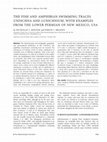
Palaeontology, Jan 1, 2006
The ichnotaxonomy and stratigraphic, geographic and environmental distribution of fish (Undichna)... more The ichnotaxonomy and stratigraphic, geographic and environmental distribution of fish (Undichna) and amphibian (Lunichnium) swimming traces are reviewed. The ichnospecies of Undichna consist of various combinations of sinusoidal waves of differing complexity. Some of the more complex ichnospecies are made up of elements of the simpler forms, and morphological subset relationships between them are presented. Such subset series represent potential taphoseries relationships (i.e. preservational variants that reflect, for example, undertrails), or series of minor behavioural variations. Such a system can be used to highlight that different ichnospecies occurring at a locality may be taphonomic or minor behavioural variants of each other. Caution should, therefore, be exercised before erecting new ichnospecies on the basis of limited material if its morphology is a subset of an existing ichnospecies. However, the naming of such simpler ichnospecies is valid if they represent a recurrent morphology, and it is valid to erect new ichnospecies whose morphology is not a subset of an existing ichnospecies. Specimens that demonstrate intergradation between ichnotaxa can be used to justify their synonomy. Ichnotaxonomic revisions reduce the number of ichnospecies in Undichna from 14 to nine. U. radnicensis, a highly variable ichnospecies, is synonymized with U. britannica on the basis of material from China that demonstrates they can intergrade. U. prava is a partial U. tricosta, which falls within the minimum diagnosis of U. simplicitas. U. gosiutensis is regarded as a subjective junior synonym of U. quina. U. westerbergensis, originally attributed to a ‘crossopterygian’ fish performing a tetrapodlike gait, is reassigned as a distinct ichnospecies within Lunichnium because it demonstrates the same morphology, representing similar behaviour, albeit by a different producer. L. anceps and L. gracile are synonymized with L. rotterodium. New specimens of U. bina and L. rotterodium are also described from the Lower Permian Robledo Mountains Formation of southern New Mexico, USA.
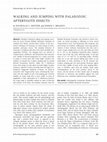
Palaeontology, Jan 1, 2006
Abundant arthropod walking and jumping traces, from the Lower Permian Robledo Mountains Formation... more Abundant arthropod walking and jumping traces, from the Lower Permian Robledo Mountains Formation of southern New Mexico, provide direct evidence of the locomotory techniques of monurans, an extinct group of archaeognathan apterygote insects. The jumping behaviour of monurans is compared with that of the extant machilid archaeognathan Petrobius. The jumping traces are referred to Tonganoxichnus robledoensis, and demonstrate that monurans were capable of forward progression via a linear succession of jumps of several times their body length. Petrobius also employs an unusual, fast, in-phase, jumping gait for normal directed locomotion; however, unlike the T. robledoensis traces, these jumps are only about one body length. In-phase trackways, referred to Stiaria intermedia from the Upper Carboniferous Tonganoxie Sandstone of Kansas, are found in association with Tonganoxichnus traces, indicating that monurans were also capable of such a fast jumping gait. Petrobius employs an escape jump that is more similar in terms of magnitude to those represented by T. robledoensis; however, the escape jump is essentially random in terms of direction and rotation of the body. Out-of-phase trackways from the Robledo Mountains Formation, also referred to Stiaria intermedia, are found preceding or following on from several Tonganoxichnus traces, and demonstrate that monurans also used normal, out-of phase, walking gaits across open ground. Analysis of these trackways demonstrates that they used a variety of gaits ranging from very slow and stable gait ratios of 1.2 : 8.8 (i.e. the propulsive backstroke phase comprises 88 per cent of the step cycle) following jumps, to fast gait ratios of 3.3 : 6.7 and 5.0 : 5.0 preceding jumps. Petrobius tends not to use such normal walking gaits unless on the undersurface of rocks, preferring to use the unusual, fast, in-phase, jumping gait over open ground. Monurans appear to have been capable of many of the same jumping behaviours as Petrobius, apart from the random escape jump. Archaeognathans are the most primitive group of true insects, and the presence of these similar types of jumping behaviours in monurans and machilids suggests that such behaviours were a primitive method of insect locomotion.
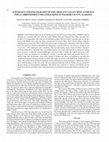
Early Pennsylvanian trace fossil-bearing deposits from the Crescent Valley Mine of Walker County ... more Early Pennsylvanian trace fossil-bearing deposits from the Crescent Valley Mine of Walker County in Alabama are correlated with those from the nearby Minkin Paleozoic Footprint Site. These represent end members of a megatracksite that spans an environmental gradient from the inland, freshwater part of a deltaic system at the Minkin site to more near shore environments at Crescent Valley, where variable salinity conditions and tidal processes prevailed. This is reflected by preservation of a depauperate ichnofauna at the Crescent Valley mine. Recorded trace fossils are identified and interpreted as amniote trackways (Attenosaurus subulensis and Cincosaurus cobbi), apterygote insect trackways (Stiaria) and jumping traces (Tonganoxichnus), myriapod trackways (Diplichnites-Diplopodichnus), invertebrate burrows (Arenicolites and Treptichnus), and bivalve resting traces (Lockeia). A continuum of trail morphologies from chevronate, to feather-stitch and leveéd forms is also observed. These are interpreted as recording the activities of juvenile xiphosurans and possibly bivalves in a shallow-water tidal environment. Arborichnus, present in deeper-water facies, is interpreted as recording the combined resting and swimming activities of adult xiphosurans. In contrast to the Minkin site, Kouphichnium is absent. The spatial and environmental separation of these different trace fossils attributed to xiphosurans reflects that of different phases in their life cycles. The environmental distinction from the Minkin site may explain the apparent absence of temnospondyl amphibians. The fish-fin trace Undichna is common at the Minkin site but absent from the Crescent Valley mine, which may be due to interrelated environmental and preservational conditions.
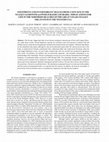
The Navajo, Nugget and other Lower Jurassic sandstones represent part of the world’s largest Meso... more The Navajo, Nugget and other Lower Jurassic sandstones represent part of the world’s largest Mesozoic sandy desert system. Navajo Sandstone outcrops are well-known and well-exposed in southern Utah and northern Arizona, where almost all significant vertebrate body fossils from this unit originate. Vertebrate ichnofaunas are also abundant in this region, although few sites are documented in great detail. By contrast, known sites to the north, in northwestern Colorado, northeastern Utah, southeastern Idaho and southwestern Wyoming, where the term Nugget Sandstone is used, are more widely scattered and, until very recently, have produced no significant body fossils. Nevertheless, the northern sites are historically important, and contribute substantially to our understanding of the ichnofaunas. We give a preliminary account of a Lower Jurassic ichnofauna from the Nugget Sandstone of southeastern Idaho excavated in 2005 through 2008. The ichnofauna includes a large sample of vertebrate and invertebrate traces attributed to dinosaurs, mammals or mammal-like (mammaloid or therapsid) species and various arthropods. Identified ichnogenera include Grallator, Otozoum, Batrachopus, Brasilichnium, Octopodichnus, Paleohelcura and Diplichnites. The ichnofauna is important because it reveals some of the smallest and best preserved mammaloid tracks ever reported from the Jurassic. In addition, the diversity and quality of preservation of the invertebrate traces is exceptional in comparison with other known localities.
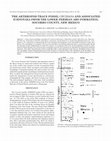
A trace fossil assemblage consisting of Cruziana problematica, Diplichnites gouldi, Diplichnites ... more A trace fossil assemblage consisting of Cruziana problematica, Diplichnites gouldi, Diplichnites isp., Monomorphichnus isp., Palaeophycus tubularis, Rusophycus carbonarius, Striatichnium cf. S. Natalis and compound traces of C. problematica × R. carbonarius is reported from the Lower Permian Abo Formation of the Joyita Hills in Socorro County, New Mexico. The assemblage is an example of the Scoyenia ichnofacies and indicates deposition under a continental regime during the last phase of Abo sedimentation in central New Mexico. It is atypical of Abo trace fossil assemblages in that it is dominated by striated bilobate traces whereas other assemblages from the Abo Formation are dominated by tetrapod and arthropod trackways. This reflects the production of this assemblage within a small ephemeral water body on a floodplain whereas other Abo assemblages formed during fleeting preservation windows on exposed surfaces after sheetfloods on the floodplain. The majority of trace fossils are attributed to notostracan branchiopod crustaceans, which are adapted to inhabit ephemeral water bodies.

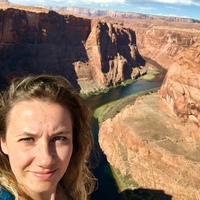





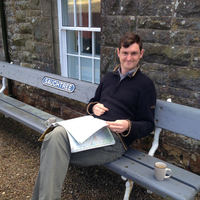
Uploads
Papers by Nicholas Minter
The invertebrate trace fossils from the Robledo Mountains Formation of the Robledo Mountains are dominated by arthropod trackways (Dendroidichnites irregulare, Diplichnites isp., Diplopodichnus biformis, Kouphichnium? isp., Lithographus hieroglyphicus, Octopodichnus cf. didactylus, Palmichnium macdonaldi, P. palmatum, P. pottsae and Stiaria intermedia), including several enigmatic arthropod trackways, as well as intergrading arthropod trackways (Diplichnites isp. × Diplopodichnus biformis, Diplopodichnus biformis × Dendroidichnites irregulare and cf. Lithographus × Diplopodichnus biformis), arthropod resting traces (cf. Lockeia, Rotterodichnium major, Selenichnites belosis nov. isp. Tonganoxichnus apacheensis nov. comb., and T. buildexensis), arthropod locomotory jumping traces (T. robledoensis), combined arthropod trackways and locomotory jumping traces (Stiaria intermedia × T. robledoensis), and arthropod grazing/raking traces (Stiallia pilosa and Striatichnium biflabellis nov. isp.). Invertebrate feeding traces (Treptichnus bifurcus) and grazing trails (Cochlichnus anguineus and looping trails) are present but rare. Trace fossils similar to the typically deep marine graphoglyptids are also present (cf. Spirorhaphe azteca), as well as horizontal helical-shaped burrows (Augerinoichnus helicoidalis) that may also have affinities with graphoglyptids. Further trace fossils described under open nomenclature include horizontal burrows and various enigmatic invertebrate trace fossils. The vertebrate trace fossils are dominated by tetrapod trackways (Batrachichnus salamandroides, Batrachichnus aff. salamandroides, Dimetropus nicolasi, D. leisneranius, Dromopus lacertoides, cf. Erpetopus, Limopus vagus, Gilmoreichnus hermitanus and Hyloidichnus bifurcatus), whilst tetrapod swimming trackways (Lunichnium rotterodium, Serpentichnus robledoensis and S. sigmoidalis nov. isp.) and fish swimming trails (Undichna bina, U. britannica and Undichna? unisulca) are also present.
The trace fossil assemblage can be considered as an example of the Scoyenia ichnofacies, although the presence of rare elements of the Mermia ichnofacies indicates that there are pre- and syn-desiccation suites of trace fossils. Cluster analysis of trace fossil distributions across nonmarine depositional settings from the Early Permian of the southwest USA reveals patterns consistent with previous models, based on qualitative observations, of the distribution of vertebrate trace fossils and their palaeoenvironmental implications. Comparisons of analyses conducted using the vertebrate, invertebrate and all trace fossils from the assemblages reveals that, for assemblages covering a limited temporal and palaeogeographic scope, vertebrate trace fossils allow greater potential for identifying trace fossil associations that enable discrimination amongst different depositional settings than invertebrate trace fossils alone, whereas a holistic approach, utilising all available trace fossil data, allows the greatest number of trace fossil associations, which correspond to different depositional settings, to be identified.
The material described herein represents a new ichnogenus of helical burrow, named Augerinoichnus helicoidalis, and is recurrent across Lower Permian localities in New Mexico. Augerinoichnus occurs in tidal flat settings from the Robledo Mountains Formation of the Robledo Mountains, fluvio-deltaic coastal plain settings from the Robledo Mountains Formation of the Doña Ana Mountains in southern New Mexico, and floodplain sandflat settings from the Abo Formation of Cañoncito de la Uva in the Joyita Hills of central New Mexico, the McLeod Hills of central New Mexico and the Fra Cristobal Mountains of central New Mexico. The report of this new ichnogenus provides important paleoecological information on foraging strategies in nonmarine paleoenvironments, as well as further evidence for the occurrence of trace fossils in nonmarine settings similar to those considered indicative of deep marine depositional settings.
The trace fossil assemblage is typical of the Scoyenia ichnofacies, and is similar to other assemblages from a range of different transitional subaqueous to subaerial settings, indicating that the distribution of trace fossils is not inextricably linked to the depositional setting itself, but rather to the environmental factors that arise. Such diverse trace fossil assemblages probably reflect relatively long-lived ephemeral water bodies, whereas more impoverished examples probably represent shorter-lived ephemeral water bodies. Assemblages such as Castle Peak, with abundant delicate arthropod trackways, probably reflect low energy conditions, conducive to the presence of an abundant vagile epifauna and the preservation of their trackways, whereas assemblages with open vertical burrows tend to lack arthropod trackways and probably reflect higher energy conditions. Trace fossil assemblages dominated by arthropod and tetrapod trackways may represent fleeting preservation windows following sheetfloods on floodplains.
The invertebrate trace fossils from the Robledo Mountains Formation of the Robledo Mountains are dominated by arthropod trackways (Dendroidichnites irregulare, Diplichnites isp., Diplopodichnus biformis, Kouphichnium? isp., Lithographus hieroglyphicus, Octopodichnus cf. didactylus, Palmichnium macdonaldi, P. palmatum, P. pottsae and Stiaria intermedia), including several enigmatic arthropod trackways, as well as intergrading arthropod trackways (Diplichnites isp. × Diplopodichnus biformis, Diplopodichnus biformis × Dendroidichnites irregulare and cf. Lithographus × Diplopodichnus biformis), arthropod resting traces (cf. Lockeia, Rotterodichnium major, Selenichnites belosis nov. isp. Tonganoxichnus apacheensis nov. comb., and T. buildexensis), arthropod locomotory jumping traces (T. robledoensis), combined arthropod trackways and locomotory jumping traces (Stiaria intermedia × T. robledoensis), and arthropod grazing/raking traces (Stiallia pilosa and Striatichnium biflabellis nov. isp.). Invertebrate feeding traces (Treptichnus bifurcus) and grazing trails (Cochlichnus anguineus and looping trails) are present but rare. Trace fossils similar to the typically deep marine graphoglyptids are also present (cf. Spirorhaphe azteca), as well as horizontal helical-shaped burrows (Augerinoichnus helicoidalis) that may also have affinities with graphoglyptids. Further trace fossils described under open nomenclature include horizontal burrows and various enigmatic invertebrate trace fossils. The vertebrate trace fossils are dominated by tetrapod trackways (Batrachichnus salamandroides, Batrachichnus aff. salamandroides, Dimetropus nicolasi, D. leisneranius, Dromopus lacertoides, cf. Erpetopus, Limopus vagus, Gilmoreichnus hermitanus and Hyloidichnus bifurcatus), whilst tetrapod swimming trackways (Lunichnium rotterodium, Serpentichnus robledoensis and S. sigmoidalis nov. isp.) and fish swimming trails (Undichna bina, U. britannica and Undichna? unisulca) are also present.
The trace fossil assemblage can be considered as an example of the Scoyenia ichnofacies, although the presence of rare elements of the Mermia ichnofacies indicates that there are pre- and syn-desiccation suites of trace fossils. Cluster analysis of trace fossil distributions across nonmarine depositional settings from the Early Permian of the southwest USA reveals patterns consistent with previous models, based on qualitative observations, of the distribution of vertebrate trace fossils and their palaeoenvironmental implications. Comparisons of analyses conducted using the vertebrate, invertebrate and all trace fossils from the assemblages reveals that, for assemblages covering a limited temporal and palaeogeographic scope, vertebrate trace fossils allow greater potential for identifying trace fossil associations that enable discrimination amongst different depositional settings than invertebrate trace fossils alone, whereas a holistic approach, utilising all available trace fossil data, allows the greatest number of trace fossil associations, which correspond to different depositional settings, to be identified.
The material described herein represents a new ichnogenus of helical burrow, named Augerinoichnus helicoidalis, and is recurrent across Lower Permian localities in New Mexico. Augerinoichnus occurs in tidal flat settings from the Robledo Mountains Formation of the Robledo Mountains, fluvio-deltaic coastal plain settings from the Robledo Mountains Formation of the Doña Ana Mountains in southern New Mexico, and floodplain sandflat settings from the Abo Formation of Cañoncito de la Uva in the Joyita Hills of central New Mexico, the McLeod Hills of central New Mexico and the Fra Cristobal Mountains of central New Mexico. The report of this new ichnogenus provides important paleoecological information on foraging strategies in nonmarine paleoenvironments, as well as further evidence for the occurrence of trace fossils in nonmarine settings similar to those considered indicative of deep marine depositional settings.
The trace fossil assemblage is typical of the Scoyenia ichnofacies, and is similar to other assemblages from a range of different transitional subaqueous to subaerial settings, indicating that the distribution of trace fossils is not inextricably linked to the depositional setting itself, but rather to the environmental factors that arise. Such diverse trace fossil assemblages probably reflect relatively long-lived ephemeral water bodies, whereas more impoverished examples probably represent shorter-lived ephemeral water bodies. Assemblages such as Castle Peak, with abundant delicate arthropod trackways, probably reflect low energy conditions, conducive to the presence of an abundant vagile epifauna and the preservation of their trackways, whereas assemblages with open vertical burrows tend to lack arthropod trackways and probably reflect higher energy conditions. Trace fossil assemblages dominated by arthropod and tetrapod trackways may represent fleeting preservation windows following sheetfloods on floodplains.